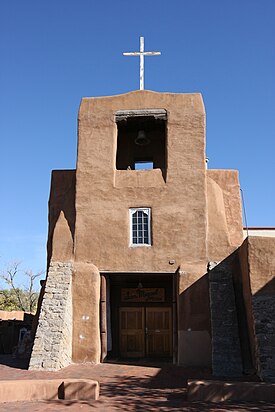San Miguel Mission
| San Miguel Archángel | |
|---|---|

The front exterior to the Chapel of San Miguel.
|
|
| Basic information | |
| Location |
Santa Fe, New Mexico |
| Geographic coordinates | 35°41′00″N 105°56′16″W / 35.68343°N 105.93767°WCoordinates: 35°41′00″N 105°56′16″W / 35.68343°N 105.93767°W |
| Affiliation | Roman Catholic |
| Country | United States of America |
| Status | Active |
| Architectural description | |
| Architectural type | Adobe construction in the Romanesque fortress church style, with heavily buttressed walls and battlements on the flat roof. |
| Architectural style | Spanish |
| Groundbreaking | 1610 |
| Completed | 1610 to 1625 |
| U.S. National Historic Landmark | |
| Added to NRHP | November 24, 1968 |
| NRHP Reference no. | 68000032 |
| Designated as NHL | November 24, 1968 |
San Miguel Mission, also known as San Miguel Chapel, is a Spanish colonial mission church in Santa Fe, New Mexico. Built between approximately 1610 and 1626, it is the oldest known church in the United States. The church was damaged during the Pueblo Revolt of 1680 but was rebuilt in 1710 following the Spanish reconquest and served for a time as a chapel for the Spanish soldiers. The wooden reredos, which includes a wooden statue of Saint Michael dating back to at least 1709, was added in 1798. Though the church has been repaired and rebuilt numerous times over the years, its original adobe walls are still largely intact despite having been hidden by later additions.
The church is a contributing property in the Barrio De Analco Historic District, which is a U.S. National Historic Landmark.
The Holy Sacrifice of the Mass is still offered at the chapel on Sundays.
San Miguel Mission, altar & interior, 1934. Historic American Buildings Survey photo
Altar (1798) of the church.
Altar (1798) of the church.
Original thick-walled church bell within San Miguel Mission at Santa Fe, New Mexico with the inscription "San Jose Rogad Por Nosotros Agosto 9 de 1356/1856" in English, the bell reads "St. Joseph Pray for us August 9th, 1356/1856". It is thought that the 8 was changed to a 3 during the late 1800s as a means of luring in tourists.
...
Wikipedia

